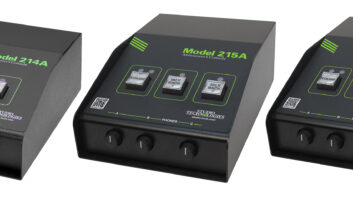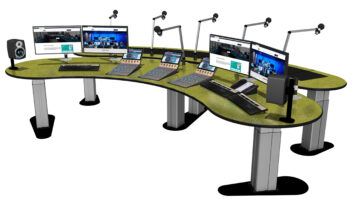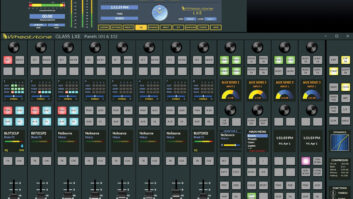(click thumbnail)Fig. 1: A wooden raceway runs the length of the hall and holds interstudio cabling.So what do you do when you are building multiple studios but have no over-ceiling space and no space to run wires under the floors? You get a carpenter to build a wire raceway as seen in Fig. 1.
Quantum Communications Chief Engineer Joe Jarjoura passed along this cost-saving tip. The raceway runs above doors and will drop to an access box at each studio, shown in Fig. 2. Inside the studio, Fig. 3 shows Joe holding the cables as they are ready to be dressed into a similar raceway to each console.
Cable runs inside buildings that weren’t designed to house radio studios don’t have to be complicated or look ugly. In fact, when you walk down the hall, the raceway is up so close to the ceiling that you don’t even notice it.
(click thumbnail)Fig. 2: At the studio entry, a box drops the cables down and through the wall.Got a neat way that you handled wiring in your station? Share it with your engineering brothers and sisters. Drop me an e-mail at [email protected]. Remember, photos should be of high resolution and sent as attachments to the message.
* * *
Bill Weeks of Hungry Wolf Electronics showed me a handheld vector impedance analyzer manufactured by AEA in California. Bill was using the AEA Via Bravo for the tuneup of WGNY(AM) in Newburgh/Middletown, N.Y.
(click thumbnail)Fig. 3: The raceway entry into the studio has room for plenty of cables.At a price of around $2,000 depending on options, this device will measure both impedance and resonant frequencies of circuits and antennas. It has worked well with Bill’s DA tuneup at WGNY.
A Smith Chart displaying the measured circuit impedances also is available using the Bravo PC Vision software and a PC, and is shown in Fig. 4.
The Via Bravo can sweep across a set of frequencies, plotting the results, as seen in the traditional R–X plot in Fig. 5. (The tuning of the array was not completed when these screen shots were taken but they give a good representation of the capabilities of the device).
In addition to the vector impedance analyzer, AEA manufactures several handheld test instruments including a TDR. See www.aeatechnology.com/products.
(click thumbnail)Figs. 4–5: The Via Bravo will provide Smith Chart plots as well as standard form impedance sweeps.He was moving a lot of coil taps in tuning the WGNY array, and Bill offers the following tip, which picks up from our suggestion to use a Sharpie or similar brand marker to indicate coil tap locations.
(click thumbnail)Fig, 6: Don’t disregard settling cracks that may get bigger and pose a leak threat.
When making a lot of adjustments or changes, select several different color markers to ensure that you won’t have to go back to the start if those adjustments don’t work out. A bottle of fingernail polish remover will wipe the old marks clean once the component clip is set.
* * *
Transmitter buildings often suffer from “settling cracks.” Maybe you’d trowel over them with a mortar fix; but that’s just a Band-Aid. The cracks will come back, as we see in Fig. 6.
As cracks widen, so does the potential for water leaks.
If you aren’t protecting your transmitter site with some kind of water detection device, save yourself a major headache, especially since sites are visited on a weekly basis anymore.
Here are a few sites that provide water sensors:
www.wateralert.com: Provides several models; one is a low-cost detector that provides an audible alarm when water is sensed, others will tie into existing alarms or remote control systems. Dorlen Products also manufactures Water Alert Sensor Cable and Ceiling Guard systems.
www.winland.com: Winland Electronics manufactures a line of sensors and alarms including popular WaterBug sensors. The improved Model WB-350 operates on a 9V battery and has an open collector output. The sensor will not alarm due to condensation or high humidity.
www.wayscale.com: Wayscale provides a variety of environmental sensors. The sensors have more features, and of course, cost more. The BMS WaterBug+Plus includes status LEDs, an internal alarm and a sensitivity adjustment; it will operate over a standard AC mains or 12/24 VDC power supply. Aqualeak sensor pads, tapes or probes are additional.

















